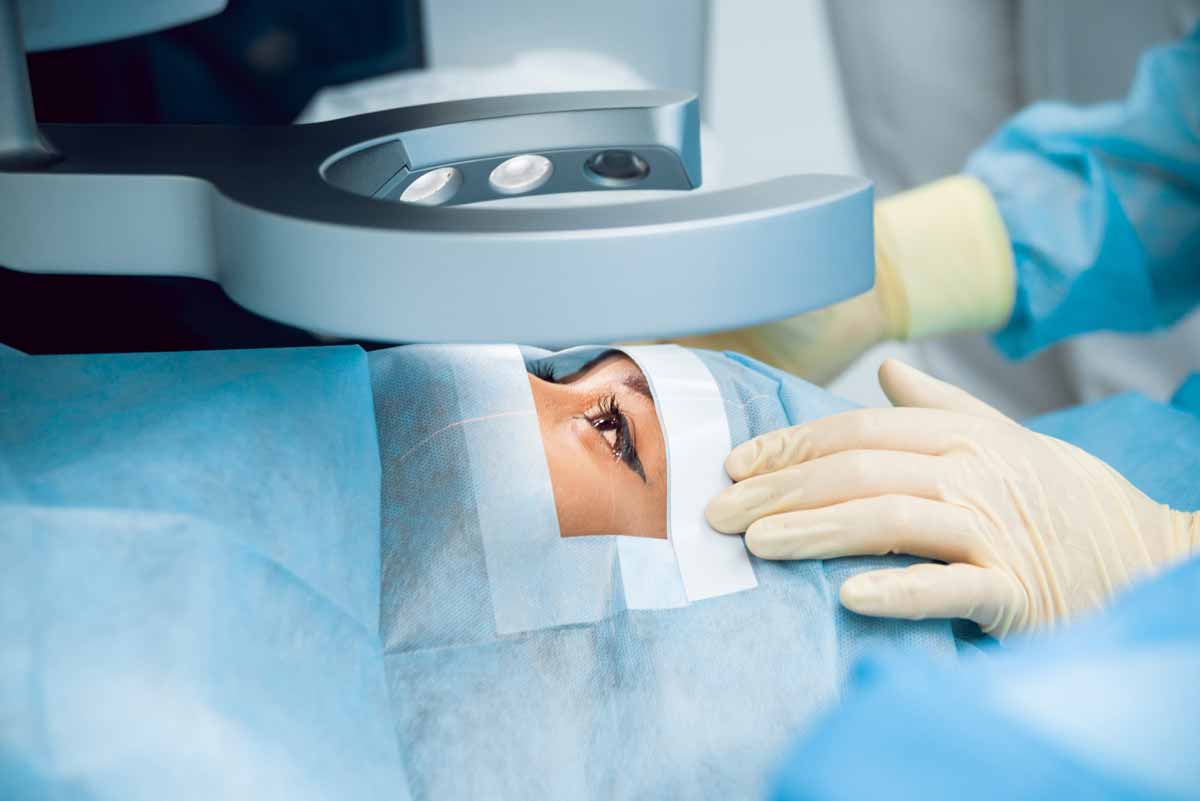Farsightedness (Presbyopia): Causes, Signs & Treatment
Home /
Last Updated:
When you are able to see things far away your eyes but unable to see things close up, you are living with farsightedness. There are two main types of farsightedness to know about. One (hyperopia) is genetic, while the other (presbyopia) comes with age.
Table of Contents
Presbyopia develops when the lens inside the eye stiffens, and the muscles that pull on that lens weaken. It’s a natural part of aging, and it cannot be prevented. Living with presbyopia symptoms often means struggling with common tasks, such as reading or chopping veggies for meals.
Presbyopia can be treated with glasses, and it can be treated with surgery. Read on to find out which option might be right for your eyes, your lifestyle, and your future.
Understand the Difference Between Presbyopia and Traditional Farsightedness
In order to perceive the world around you, your eyes must be able to focus on things that are both close to your face and far from your body. When you can see things close to you with precision but things far from you seem fuzzy or indistinct, you are living with a condition known as farsightedness.
It would seem that everyone struggling with seeing things far from them would have the same medical factors at play. But in reality, there are two very different types of farsightedness, and how they are addressed varies.
You deserve clear vision. We can help.
With 135+ locations and over 2.5 million procedures performed, our board-certified eye surgeons deliver results you can trust.
Your journey to better vision starts here.
In the traditional type of farsightedness, known as hyperopia, the eyeball is too short. That means light that passes through the eye does not come into focus on the retina at the back of the eye. For most people with hyperopia, distant images seem fuzzy. But in advanced cases of hyperopia, all images are fuzzy, whether they are near or far.
The National Eye Institute reports that 5 to 10 percent of Americans have hyperopia, and the condition can impact both children and adults. It can run in families, and sometimes, people develop the condition in youth and see it worsen with age.
Presbyopia also causes items far from the eyes to appear indistinct or fuzzy, but unlike hyperopia, the shape of the eye is not to blame. Also, unlike hyperopia, genetics do not play a strong role.
Instead, presbyopia involves aging. As the body ages and the eyes change, it becomes harder for the eyes to focus on things held close to the face. Those age-related changes give the condition its name. As the American Academy of Ophthalmology clarifies, the word presbyopia, when translated from the Greek, means “old eye.”
These two conditions are distinct, and the way in which they develop and are treated are also distinct. Knowing how presbyopia is treated can help you understand what your next steps should be if you are not seeing as clearly as you once did.

How Presbyopia Develops
Muscles line the human body from head to foot. Whenever we want to move from one place to another, our muscles play a role. Muscles also help us to complete tasks we might not even think about, such as breathing or moving our eyes.
When we want to shift from looking at something far away, like the road stretching before us, to something close to us, like the map on our cellphone, tiny muscles do the work. They pull on the lens inside the eye, and that pulling changes the shape of the lens and brings close items into focus.
As we age, muscles stiffen. This condition is known as sarcopenia, and according to Science Daily, the condition typically appears around the 40th birthday. With each year, the muscles get just a bit weaker until the 75th birthday, when muscles decline even faster.
It’s easy to notice larger muscles in the arms or legs. As they get weaker with age, we may notice that our clothes seem looser or that it takes more effort to do things we once did naturally. We may have obvious clues that tell us that our large muscle groups are changing. We may have no such signals about smaller muscles, including those in the eyes. But those changes are still happening.
Weaker muscles in the eye cannot pull on the lens with the force that might be needed to bring close items into focus. Those eye muscle changes are paired with another side effect of aging that can affect vision.
With age, the lens inside the eye grows stiffer. That stiff lens does not shift as easily as it once did, meaning that a gentle tug of the muscles may not adjust its shape. Only a large tug will do the trick. Since weakened muscles may not be able to offer that tug, it may be hard to bring close items into focus.
The Canadian Association of Optometrists points out that presbyopia is a natural consequence of aging. Stiffer lenses and weaker muscles simply come with age, and those changes cannot be entirely prevented. If we live into advanced age, these changes may happen whether we expect them or not.
As muscles continue to weaken and the lens continues to stiffen, it may grow harder and harder to see things when they are close to your eyes. The American Optometric Association reports that these changes tend to even out at age 60, so the difficulties you experience may not continue to worsen after that time.
Living With Presbyopia
Since presbyopia is caused by age and cannot be prevented, it is not surprising that the condition is common. In fact, according to research published in the journal Ophthalmology, there were an estimated 1.8 billion people living with this condition in 2015.
It may be reassuring to know that the condition does not tend to worsen throughout all of life. The vision loss you are living with in your 60s is likely to remain with you for the rest of life rather than growing more severe every year. But even mild to moderate presbyopia can cause symptoms that can be hard to live with.
According to Mayo Clinic, people with presbyopia may:
- Hold reading materials far from their eyes to sharpen the letters.
- Struggle to see clearly in dim light.
- Experience headaches or eyestrain after performing tasks requiring close vision, such as reading or sewing.
- Feel as though books or other reading materials seem blurred or indistinct.
For some people, this may be simply bothersome. You may find that it’s hard to read menus at restaurants or chop vegetables for dinner, and you may not enjoy reading the Sunday paper. Those changes can be troubling, but you may not find that they limit your daily life.
But some people rely on close vision to help them at work or in their hobbies. If you work as a seamstress, a surgeon, or a computer programmer, your low vision may make it hard for you to do your job and support your family. For you, this loss may be acutely felt.
There is some evidence that all of us may experience the impact of presbyopia more than we have in the past. According to PC Magazine, the average adult spends 3.3 hours per day using a mobile phone. That number rises every year.
As we grow more connected, we rely on our phones to help us navigate the world around us. The text on a phone screen can be remarkably small, and if you are spending hours each day trying to see that small text, you may be acutely aware of the changes in your vision. That could prompt you to seek out solutions, so you can use your phone in an optimal manner.
Treating Presbyopia with Glasses

Glasses made to assist with presbyopia, according to Mayo Clinic, have a power range from 1 diopter to 3 diopters. Glasses like this are sold without a prescription. You can walk into a drug store or pharmacy and try out the glasses available in order to find one that seems to help you see properly.
You can also visit your local eye doctor and have glasses specifically made to help you cope with presbyopia. Some people choose to wear bifocals, in which the top portion of the lens is made to help you see things far away, and the bottom portion is made to help you see things close to you. This placement follows the natural arc of your eye, as you tend to look up when you are looking at things far from you, and you look down when you are reading or doing close work.
Bifocals can be helpful, as you can wear them all day long regardless of what you might be doing. While you might need to take reading glasses off in order to drive or tackle some other distance task, you would not need to remove bifocals.
Bifocals do come with some traits that some people find bothersome. For example, according to University Health News, bifocals have a sharp line that delineates the shift between distance and close vision. That line could irritate you and take adjustment time. Some bifocals have a progressive field of vision that eliminates the sharp line, but those lenses can distort items to your right or left field of vision. You may adjust to that sensation, or you may not. Health insurance provider VSP reports that some people get used to progressive lenses within a few minutes, while others take weeks or longer to adjust.
It’s also important to note that bifocals and progressives are made to help you see things close to your face when you are looking down. There may be times in which you are looking down, but you need to be able to see things at a distance. For example, if you are walking down a slippery flight of stairs, the ability to see those stairs when you place your foot down could mean the difference between falling and sticking the landing.
In a study of the issue, researchers found that giving people traditional lenses, rather than bifocals or transition lenses, reduced the fall rate by about 8 percent. They note that this change could be vital in those people who spend a great deal of time outside.
Glasses are typically the first solution offered for presbyopia because they are easy to access and they come with few serious health risks. But clearly, glasses are not right for all eyes and all lifestyles. If you do not think your eyes will benefit from glasses, there are other solutions that may suit you better.
You deserve clear vision. We can help.
With 135+ locations and over 2.5 million procedures performed, our board-certified eye surgeons deliver results you can trust.
Your journey to better vision starts here.
Treating Presbyopia With Surgery
Glasses can help some people to find relief from presbyopia, but they do come with side effects. And using glasses to help with this form of nearsightedness can mean constantly putting glasses on and taking them off again. You may need pockets in all of your shirts to carry your glasses, and you may not feel complete unless you have some sort of lens nearby. This could be a tremendous drawback. Surgery can eliminate that drawback.

Surgical procedures are made to permanently alter the shape or structure of your eye. One of the most common surgical procedures, laser-assisted in-situ keratomileusis (LASIK), involves removing a predetermined amount of corneal tissue, so light can move through the eye in an ideal manner.
Surgeons who offer this procedure often remind their patients that they may need glasses later in life. That is because, as the American Refractive Surgery Council points out, LASIK cannot prevent presbyopia.
During a LASIK procedure, the doctor creates a small flap in the front of the eye and folds that flap back. A laser shines on the cornea tissue below until a specific amount is removed, and the flap is replaced. Since this procedure does not touch eye muscles or the eye lens, it cannot stop presbyopia. Those underlying structures are just not touched.
If presbyopia damage is severe, LASIK may offer a solution. As researchers writing in the British Journal of Ophthalmology point out, some surgeons use LASIK to amend the shape of one eye, so close vision is crisp and clear. They may leave the other eye untouched, so this eye can see things at a distance. This type of surgery can involve an adjustment period, but it can allow people to see clearly both near and far without the use of glasses. In this article, researchers say that 80 percent to 98 percent of patients who had this LASIK procedure are happy with the results. Patients must be sure that this is the right approach for them, however, as it cannot be reversed.
In a different type of surgery, doctors make a small cut in the side of the eye and use sound waves to break the existing lens apart. If the lens is brittle and likely to break apart, doctors may make a larger incision and remove the lens in one piece. With that lens removed, doctors can place a new lens inside the eye and amend the vision problem at the source.
There are many types of lenses that can be used in these surgeries, including lenses with bifocal power. These lenses work in much the same manner as bifocal glasses, but the lens is inside the eye. According to research published in Graefe’s Archive for Clinical and Experimental Ophthalmology, these lenses can result in lower contrast sensitivity. But most patients studied here did not notice or mind that change.
Eye surgeries like this can be a permanent solution for vision problems, and since they are surgeries, your eye must be healthy enough to heal after the procedure. Surgery may not be best for you if you have:
- Dry eyes.
- Autoimmune disorders.
- Cardiovascular disease.
- Severe allergies.
- Diabetes.
- Other eye health issues, such as glaucoma.
Your surgeon will need to assess your eye health carefully before the surgery, to ensure that you are a good candidate for the help surgery can offer.
Trust an Expert With Your Eyes
You know your eyes better than anyone else. You also know your lifestyle better than anyone else. But you may not have the clinical expertise to fix your eyes properly. That is why it’s vital to work with an eye health expert who listens well and performs beautifully. That is what we can offer you.
Our doctors are exceptional clinicians who really listen to their patients. We perform comprehensive examinations before every procedure, and we try to understand what optimal eye health really means to you and your lifestyle. We develop a plan of action for your eyes, but we take no steps unless you agree. And if you have surgery, you will be under the care of a surgeon with the expertise and skill to do the job right.
We’d like to schedule your consultation appointment. Please contact us to get started.
FAQs About Farsightedness
What causes farsightedness?
The most common form of farsightedness is caused by natural biological variations in eyeball development. The axial length of your eyeball may be too short, or the curvature of your cornea or lens may be flatter than normal. Other causes include age-related changes in refractive index, lens dislocation, surgical overcorrection/under-correction and diabetes.
Can farsightedness be corrected?
Yes. The standard treatments for farsightedness are eyeglasses or contact lenses. Surgical options to correct farsightedness include LASIK, LASEK, photorefractive keratectomy (PRK), laser thermal keratoplasty (LTK) and intraocular lens implants.
Can you wear glasses for farsightedness?
Yes. In fact, wearing glasses is the simplest form of farsightedness treatment. For farsightedness, doctors prescribe glasses that feature convex lenses. The shape of the lenses compensates for the refractive error in your eyes.
You deserve clear vision. We can help.
With 135+ locations and over 2.5 million procedures performed, our board-certified eye surgeons deliver results you can trust.
Your journey to better vision starts here.
References
- Farsightedness. National Eye Institute.
- What Is Presbyopia? (September 2017). American Academy of Ophthalmology.
- Study Explains Why Muscles Weaken With Age and Points to Possible Therapy. (August 2011). Science Daily.
- Presbyopia. Canadian Association of Optometrists.
- Adult Vision: 41 to 60 Years of Age. American Optometric Association.
- Global Prevalence of Presbyopia and Vision Impairment From Uncorrected Presbyopia: Systematic Review, Meta-Analysis and Modeling. (October 2018). Ophthalmology.
- Tech Addition by the Numbers: How Much Time We Spend Online. (June 2018). PC Magazine.
- What is Presbyopia? Getting a Read on a Common Eyesight Condition. (May 2018). University Health News.
- Glasses, Contacts, and LASIK—Progressives: The Perfect Prescription. VSP.
- Effect on Falls of Providing Single Lens Distance Vision Glasses to Multifocal Glasses Wearers: Visible, Randomized Controlled Trial. (May 2010). The BMJ.
- A Review of the Surgical Options for the Correction of Presbyopia. (2016). British Journal of Ophthalmology.
- Contrast Sensitivity With Bifocal Intraocular Lenses Is Halved, as Measured with the Freiburg Vision Test (FrACT), Yet Patients Are Happy. (January 2014). Graefe’s Archive for Clinical and Experimental Ophthalmology.
- Axial Length, Anterior Chamber Depth-A Study in Different Age Groups and Refractive Errors. (October 2013). Journal of Clinical and Diagnostic Research.
- Photorefractive Keratectomy (PRK) versus laser-assisted in situ keratomileusis (LASIK) for hyperopia correction. (June 2012). The Cochrane Database of Systematic Reviews.
- Long-sightedness – Treatment. (July 2016). National Health Service.
- TREATMENT OPTIONS FOR FARSIGHTEDNESS. (December 2016). Barnet Dulaney Perkins Eye Center.
This content is for informational purposes only. It may have been reviewed by a licensed physician, but is not intended to serve as a substitute for professional medical advice. Always consult your healthcare provider with any health concerns. For more, read our Privacy Policy and Editorial Policy.

